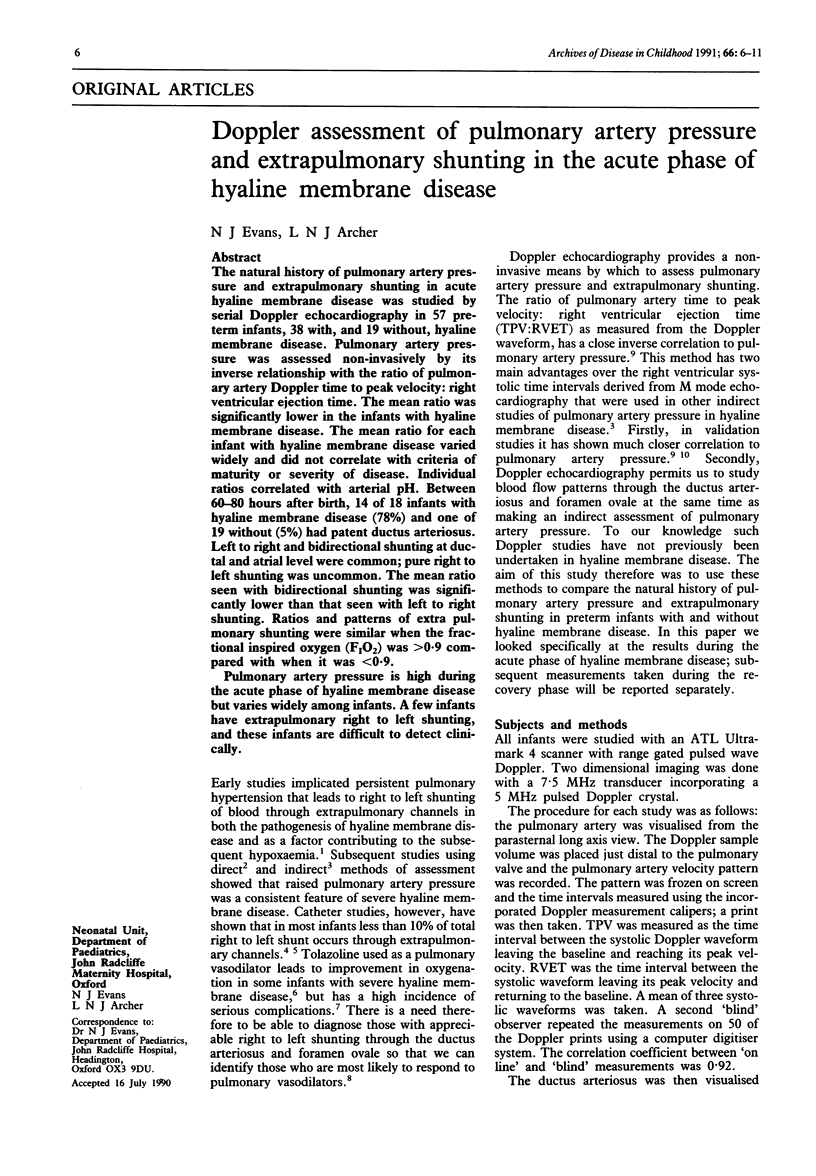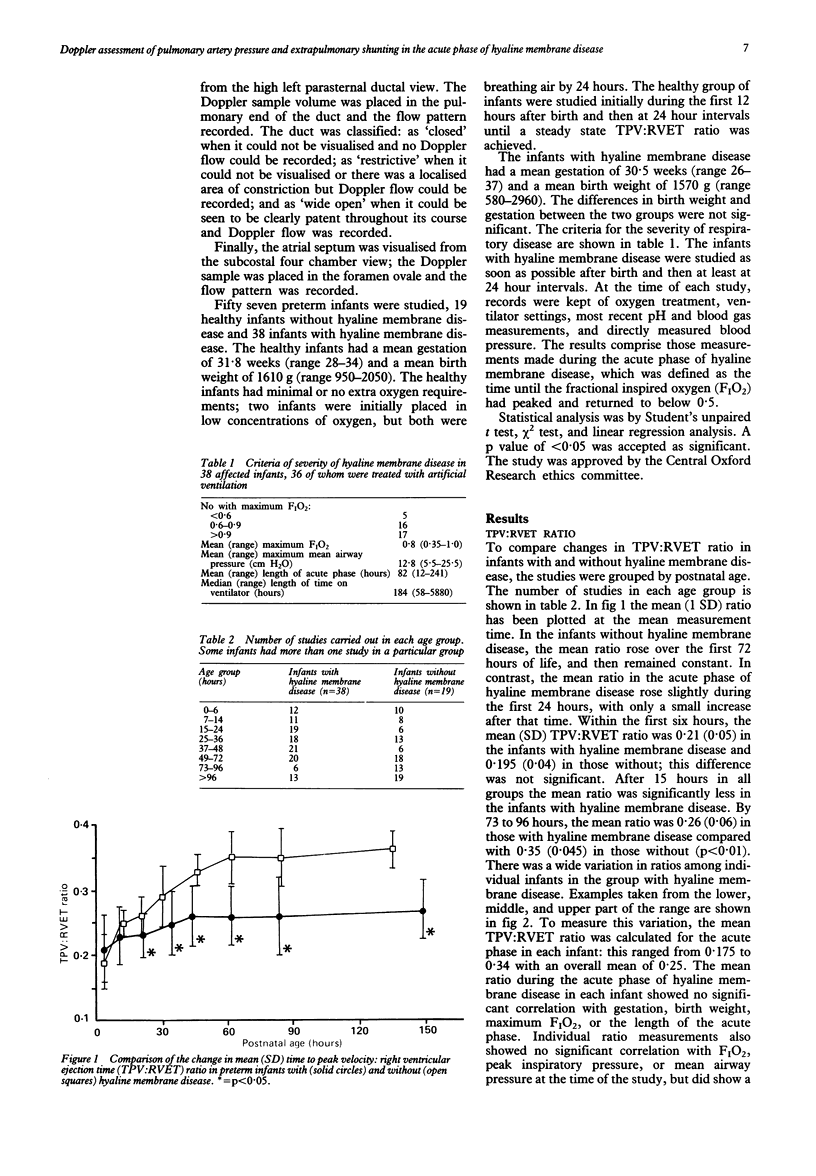Abstract
The natural history of pulmonary artery pressure and extrapulmonary shunting in acute hyaline membrane disease was studied by serial Doppler echocardiography in 57 preterm infants, 38 with, and 19 without, hyaline membrane disease. Pulmonary artery pressure was assessed non-invasively by its inverse relationship with the ratio of pulmonary artery Doppler time to peak velocity: right ventricular ejection time. The mean ratio was significantly lower in the infants with hyaline membrane disease. The mean ratio for each infant with hyaline membrane disease varied widely and did not correlate with criteria of maturity or severity of disease. Individual ratios correlated with arterial pH. Between 60-80 hours after birth, 14 of 18 infants with hyaline membrane disease (78%) and one of 19 without (5%) had patent ductus arteriosus. Left to right and bidirectional shunting at ductal and atrial level were common; pure right to left shunting was uncommon. The mean ratio seen with bidirectional shunting was significantly lower than that seen with left to right shunting. Ratios and patterns of extra pulmonary shunting were similar when the fractional inspired oxygen (FIO2) was greater than 0.9 compared with when it was less than 0.9. Pulmonary artery pressure is high during the acute phase of hyaline membrane disease but varies widely among infants. A few infants have extrapulmonary right to left shunting, and these infants are difficult to detect clinically.
Full text
PDF





Images in this article
Selected References
These references are in PubMed. This may not be the complete list of references from this article.
- Chu J., Clements J. A., Cotton E. K., Klaus M. H., Sweet A. Y., Tooley W. H., Bradley B. L., Brandorff L. C. Neonatal pulmonary ischemia. I. Clinical and physiological studies. Pediatrics. 1967 Oct;40(4 Suppl):709–782. [PubMed] [Google Scholar]
- Egan E. A., Hessler J. R. Positive end expiratory pressure (PEEP) and right to left shunting in immature goats. Pediatr Res. 1976 Nov;10(11):932–937. doi: 10.1203/00006450-197611000-00006. [DOI] [PubMed] [Google Scholar]
- Evans N. J., Archer L. N. Postnatal circulatory adaptation in healthy term and preterm neonates. Arch Dis Child. 1990 Jan;65(1 Spec No):24–26. doi: 10.1136/adc.65.1_spec_no.24. [DOI] [PMC free article] [PubMed] [Google Scholar]
- Friedman Z., Demers L. M. Essential fatty acids, prostaglandins, and respiratory distress syndrome of the newborn. Pediatrics. 1978 Mar;61(3):341–347. doi: 10.1542/peds.61.3.341. [DOI] [PubMed] [Google Scholar]
- Halliday H., Hirschfeld S., Riggs T., Liebman J., Fanaroff A., Bormuth C. Respiratory distress syndrome: echocardiographic assessment of cardiovascular function and pulmonary vascular resistance. Pediatrics. 1977 Oct;60(4):444–449. [PubMed] [Google Scholar]
- Hammerman C., Strates E., Valaitis S. The silent ductus: its precursors and its aftermath. Pediatr Cardiol. 1986;7(3):121–127. doi: 10.1007/BF02424985. [DOI] [PubMed] [Google Scholar]
- Hirschfeld S., Meyer R., Schwartz D. C., Kofhagen J., Kaplan S. The echocardiographic assessment of pulmonary artery pressure and pulmonary vascular resistance. Circulation. 1975 Oct;52(4):642–650. doi: 10.1161/01.cir.52.4.642. [DOI] [PubMed] [Google Scholar]
- Houston A. B., Lim M. K., Doig W. B., Gnanapragasam J., Coleman E. N., Jamieson M. P., Pollock J. C. Doppler flow characteristics in the assessment of pulmonary artery pressure in ductus arteriosus. Br Heart J. 1989 Oct;62(4):284–290. doi: 10.1136/hrt.62.4.284. [DOI] [PMC free article] [PubMed] [Google Scholar]
- Johnson G. L., Cunningham M. D., Desai N. S., Cottrill C. M., Noonan J. A. Echocardiography in hypoxemic neonatal pulmonary disease. J Pediatr. 1980 Apr;96(4):716–720. doi: 10.1016/s0022-3476(80)80752-9. [DOI] [PubMed] [Google Scholar]
- Kitabatake A., Inoue M., Asao M., Masuyama T., Tanouchi J., Morita T., Mishima M., Uematsu M., Shimazu T., Hori M. Noninvasive evaluation of pulmonary hypertension by a pulsed Doppler technique. Circulation. 1983 Aug;68(2):302–309. doi: 10.1161/01.cir.68.2.302. [DOI] [PubMed] [Google Scholar]
- Käpä P., Koivisto M., Viinikka L., Ylikorkala O. Increased plasma immunoreactive 6-keto-prostaglandin F1 alpha levels in newborns with idiopathic respiratory distress syndrome. Pediatr Res. 1982 Oct;16(10):827–829. doi: 10.1203/00006450-198210000-00005. [DOI] [PubMed] [Google Scholar]
- Levin A. R., Spach M. S., Boineau J. P., Canent R. V., Jr, Capp M. P., Jewett P. H. Atrial pressure-flow dynamics in atrial septal defects (secundum type). Circulation. 1968 Apr;37(4):476–488. doi: 10.1161/01.cir.37.4.476. [DOI] [PubMed] [Google Scholar]
- Lyrene R. K., Philips J. B., 3rd Control of pulmonary vascular resistance in the fetus and newborn. Clin Perinatol. 1984 Oct;11(3):551–564. [PubMed] [Google Scholar]
- McIntosh N., Walters R. O. Effect of tolazoline in severe hyaline membrane disease. Arch Dis Child. 1979 Feb;54(2):105–110. doi: 10.1136/adc.54.2.105. [DOI] [PMC free article] [PubMed] [Google Scholar]
- McMurphy D. M., Heymann M. A., Rudolph A. M., Melmon K. L. Developmental changes in constriction of the ductus arteriosus: responses to oxygen and vasoactive agents in the isolated ductus arteriosus of the fetal lamb. Pediatr Res. 1972 Apr;6(4):231–238. doi: 10.1203/00006450-197204000-00004. [DOI] [PubMed] [Google Scholar]
- Murdock A. I., Kidd B. S., Llewellyn M. A., Reid M. M., Swyer P. R. Intrapulmonary venous admixture in the respiratory distress syndrome. Biol Neonate. 1970;15(12):1–7. doi: 10.1159/000240204. [DOI] [PubMed] [Google Scholar]
- Nelson R. M., Egan E. A., Eitzman D. V. Increased hypoxemia in neonates secondary to the use of continuous positive airway pressure. J Pediatr. 1977 Jul;91(1):87–91. doi: 10.1016/s0022-3476(77)80454-x. [DOI] [PubMed] [Google Scholar]
- Roberton N. R., Dahlenburg G. W. Ductus arteriosus shunts in the respiratory distress syndrome. Pediatr Res. 1969 Mar;3(2):149–159. doi: 10.1203/00006450-196903000-00007. [DOI] [PubMed] [Google Scholar]
- Rudolph A. M., Yuan S. Response of the pulmonary vasculature to hypoxia and H+ ion concentration changes. J Clin Invest. 1966 Mar;45(3):399–411. doi: 10.1172/JCI105355. [DOI] [PMC free article] [PubMed] [Google Scholar]
- Stevenson D. K., Kasting D. S., Darnall R. A., Jr, Ariagno R. L., Johnson J. D., Malachowski N., Beets C. L., Sunshine P. Refractory hypoxemia associated with neonatal pulmonary disease: the use and limitations of tolazoline. J Pediatr. 1979 Oct;95(4):595–599. doi: 10.1016/s0022-3476(79)80777-5. [DOI] [PubMed] [Google Scholar]




